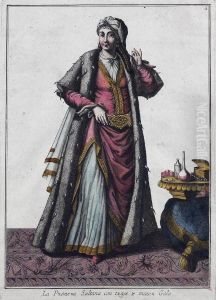Juan Bautista Bru De Ramn Paintings
Juan Bautista Bru de Ramón was a Spanish painter and sculptor, remembered primarily for his contributions to the Neoclassical movement, which sought to revive the art and culture of ancient Greece and Rome. Born in Valencia, Spain, in 1740, Bru de Ramón's artistic inclination and talent were evident from a young age. He initially trained under local artists in Valencia before moving to Madrid to further his studies. His education in Madrid, particularly at the Royal Academy of Fine Arts of San Fernando, played a crucial role in shaping his artistic techniques and philosophical outlook.
Bru de Ramón's work was marked by a meticulous attention to detail and a strong adherence to the principles of Neoclassicism, emphasizing harmony, clarity, and restraint. His career spanned a period of significant cultural and political change in Spain, which was reflected in the evolution of his artistic style. Despite the dominance of Neoclassicism during his lifetime, Bru de Ramón managed to infuse his works with a personal touch that set them apart from those of his contemporaries. He was particularly renowned for his religious paintings and sculptures, which were commissioned by various churches and cathedrals across Spain. These works often depicted biblical scenes and figures, rendered with a profound sense of realism and emotional depth.
In addition to his religious artworks, Bru de Ramón also gained acclaim for his portraits and historical paintings. His ability to capture the essence and character of his subjects was widely admired, making him a sought-after portraitist among the Spanish nobility. Despite his success, Bru de Ramón remained deeply committed to his artistic principles, resisting the temptation to conform to the changing tastes and fashions of his time.
Juan Bautista Bru de Ramón's legacy is a testament to his mastery of Neoclassical art and his dedication to portraying the spiritual and human aspects of his subjects. He passed away in 1799, leaving behind a body of work that continues to be celebrated for its beauty, precision, and emotional resonance. His contributions to Spanish art have been recognized through various exhibitions and retrospectives, ensuring that his influence endures well beyond his lifetime.



